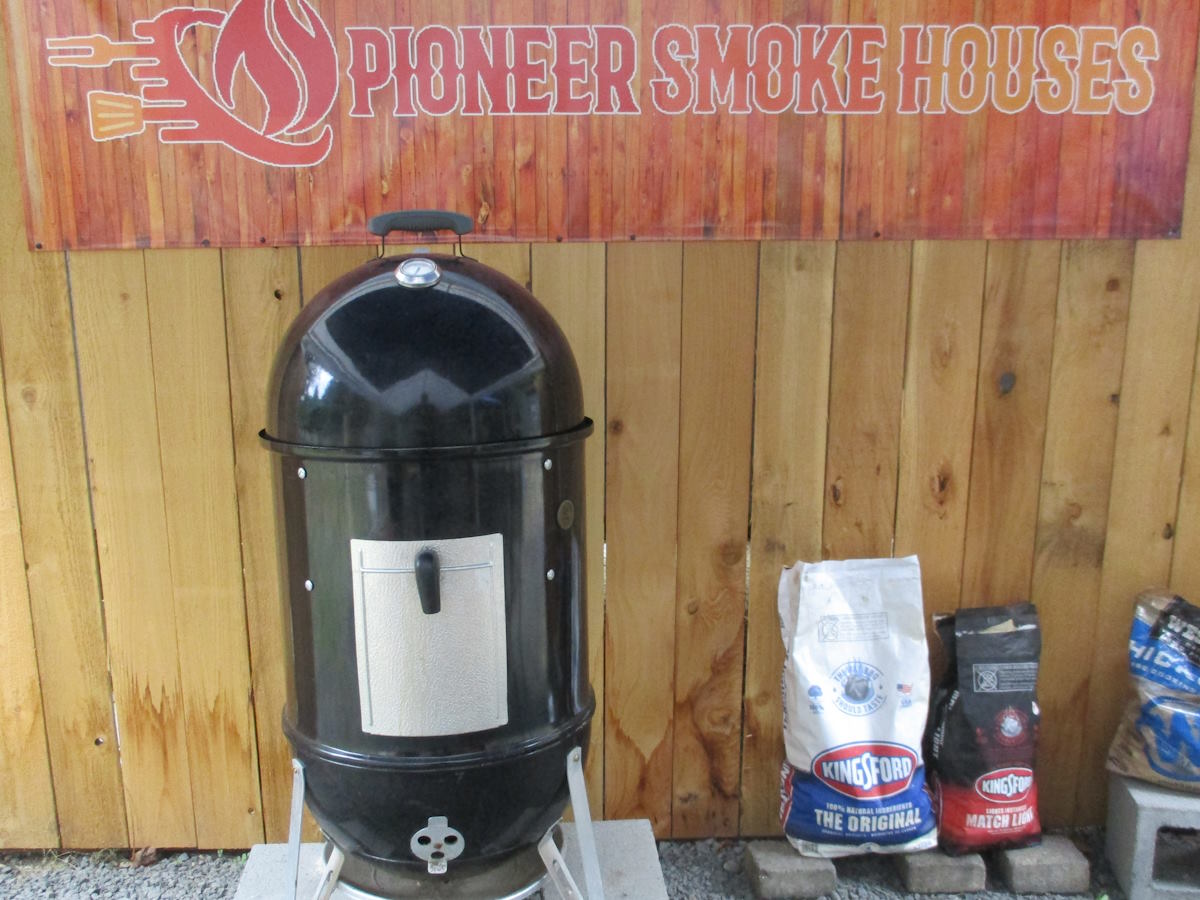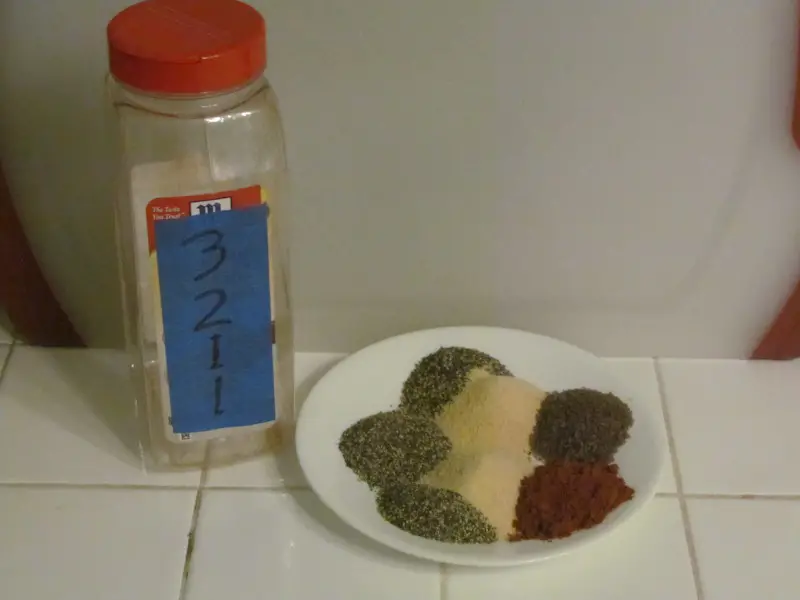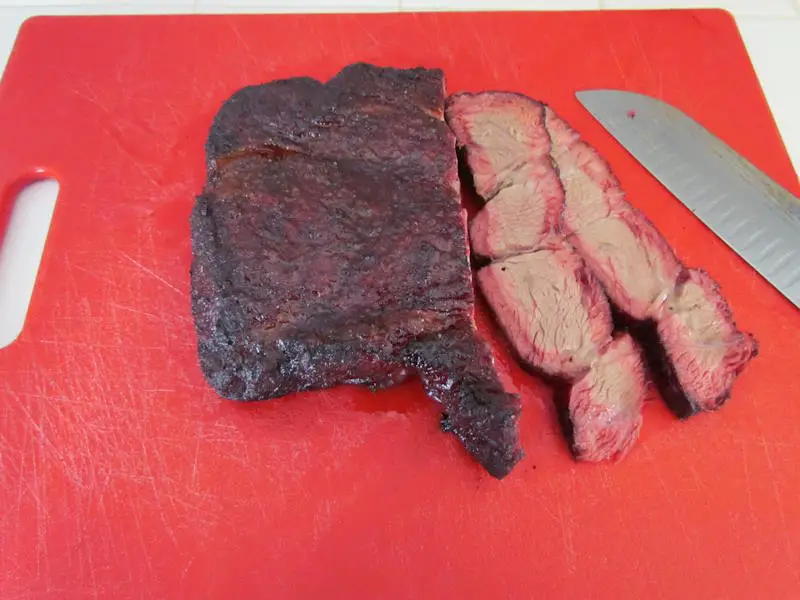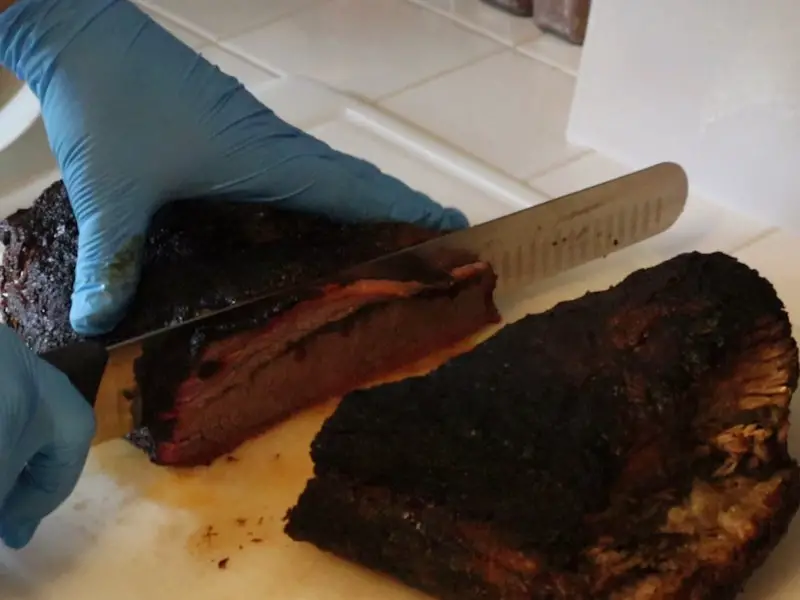
If you want to make Perfectly Smoked Meat on the Weber Smokey Mountain Cooker, I have some excellent tips! These tips will make it super easy for you to learn and become a pro at smoking meat.
This guide will go through all the important steps of smoking meat on the WSM cooker. We’ll talk about picking the right meat, getting it ready (like cutting off excess fat, adding yummy seasonings, or soaking it in marinade), creating a fantastic smoke ring, knowing when the meat is perfectly cooked, letting it rest, and much more.
So, let’s start this amazing journey to becoming a smoking expert!
Note: most links in this article are Amazon.com Affiliate links, see Affiliate Disclosure, thank you.
Choosing the right type of meat for Perfectly Smoked Meat on the Weber Smokey Mountain
When selecting the ideal meat for perfectly smoked meat on the Weber Smokey Mountain Cooker, several factors should be considered. First, consider the texture of the meat or fat content.
When selecting a good cut of meat for smoking, choose high-fat content cuts; lean pieces tend to dry out during the smoking process. Pieces with high-fat content, like pork shoulder, beef rib roast, beef brisket, or even beef chuck roast, will get you better results.
The size of the cut of meat matters. Not only do you need to consider the 18-inch cooking grate of the WSM, but also the amount of time it will take to get an even temperature throughout the piece of meat. Cuts like a 12-pound brisket can take 13 or more hours to reach 195 degrees throughout the roast.
However, a rack of ribs can be evenly cooked in 4 hours if you maintain a consistent temperature during the entire cook. Chuck roast is a bit of a wild card because the amount of connective tissue that runs through it requires a long time to break down. So, never underestimate the time needed to get tender meat.
Consider a reverse sear method if you choose to go with a lean piece of meat, such as a beef or pork loin. Smoke the meat to an internal temperature of 128 degrees. Rest your meat for 15 minutes for cuts under 2 pounds and up to 30 minutes for a 5-pound cut. Then, sear all sides on a grill or in a cast iron pan. The result will be a nice smokey flavor and that crisp crust everybody loves.
Finally, as mentioned before, many cuts of meat need time for the connective tissue to break down. The time required for most types can be directly related to the size. A brisket will break down perfectly when cooked low and slow to an internal temperature somewhere between 195 and 203 degrees, and they are not all the same.
Smaller pieces of meat will require many hours for the connective tissue to break down, so you should resist the urge to rush your cook. Cooking temperatures under 225 degrees will get the best results and can be achieved on the Weber Smokey Mountain Cooker by reducing the vents to the minimum.
Ultimately, understanding how different cuts of meat behave in terms of size and compatibility with smoking techniques ensures an optimal outcome when using a Weber Smokey Mountain Cooker.
Preparing the meat for smoking – trimming, marinating, and seasoning
When it comes to preparing meat for smoking in a Weber Smokey Mountain, attention to detail is paramount. When trimming, start with removing any hard fat that will not render, excessive fat should be removed.
Anything more than a ¼ inch of fat tends not to render well. If you wish to leave a thicker layer of fat cap, consider scoring it to aid in rendering. Scoring a fat cap on a pork shoulder can produce some yummy pieces resembling bacon bites when crisped up.
In trimming, you should look for any connective tissue that can be removed. Removing the connective tissue and tying the roast with butcher’s string on small to medium cuts will allow the meat to cook evenly and quickly.
Marinating can be a great way to add flavor, especially to small cuts like chuck roast or your favorite thick-cut steak. A marinade can be as simple as some broth and your favorite barbeque sauce or as complex as you wish with a detailed mixture of spices and sauces.
Liquids like vinegar and citrus juices can aid in the marinating process and help tenderize the meat. Use care when adding salt because it tends to draw liquid out of the meat and will need plenty of time to draw flavored liquid back into the meat, the process of Osmosis.

When it comes to seasoning, each meat has its unique characteristics, and by understanding these profiles, we can create pairings that enhance the overall dining experience.
Let’s start with beef; its rich and robust flavor pairs well with bold spices like black pepper, garlic, and smoked paprika. A classic combination for beef is a simple blend of salt, pepper, and garlic powder, allowing the natural flavors to shine through. Cumin, cayenne pepper, or chili powder can add depth and smokiness to chuck roast or reverse-seared steaks for those seeking a bolder taste.
Pork shoulder or ribs match well with garlic and brown sugar. Consider lightening the brown sugar or balancing it with something spicy, like red pepper flakes. The natural flavor of pork is a meat that goes well with a sweet smoke like pecan, so resist the temptation to overseason.
Moving on to poultry, chicken, and turkey offer a more delicate flavor profile. Herbs such as rosemary, thyme, sage, and parsley complement their mild taste exceptionally well. Lemon zest or lemon pepper seasoning adds brightness to roasted chicken dishes, while garlic and onion powder will add sweet spices that complete the pairing.
Remember that the Weber Smokey Mountain will impart a light, smokey flavor to your food with even the cleanest burning fuel.

Achieving a flavorful smoke ring on your meat
Getting a smoke ring on your meat in a Weber Smokey Mountain can be easy if you pay attention to a few details. First, let us talk about what that cool pink smoke ring actually is.
It happens when a substance called myoglobin combines with nitric oxide, which makes the myoglobin change color and turn a little red, like rust. You can do a few things to have the best chance of getting a smoke ring.
Start by keeping your meat as cold as possible. If you can keep it around 30 degrees before putting it in the smoker, that is a good way to begin. Next, use charcoal briquets, or even better, lump charcoal because it produces more nitric oxide.
When you add wood, use cuts with the bark still on them, and make sure they are not overly seasoned or dried. Keep the smoker temperature around 225 degrees so the nitric oxide has enough time to soak into the meat before it reaches 140 degrees.
Lastly, keep the surface of the meat moist by spritzing it with water. This helps the smoke stick to the meat. If everything else fails, you can cheat a little by adding a small amount of progue powder or Quick Tender to the dry rub.
It will help create a similar reaction. But remember, the smoke ring is more of a visual treat than a flavor enhancer. You should really focus on building a delicious bark by cooking at low temperatures with clean smoke.
Timing and knowing when the meat is perfectly smoked on the Weber Smokey Mountain
The Weber Smokey Mountain Cooker is the perfect tool to achieve perfectly smoked meat because of the precise temperature control. With a bit of practice, you will know exactly when the meat is perfectly smoked and roughly how much time it should take.
First, you need to monitor the temperature inside the WSM and inside the meat, AKA internal temperature. The Weber Smokey Mountain comes equipped with a very reliable temperature gauge mounted in the lid. Many smokers have very poor thermometers that can be off by 25 or more degrees, but typically not this smoker.
You will need a probe thermometer to monitor the meat’s internal temperature constantly. If you choose a wired probe, there is a convenient gourmet to feed the cord through, but wireless thermometers will not require a passthrough.
The temperature inside the WSM should always be 25 degrees or higher than the meat finished temperature. This temperature will ensure that the cooking process is always moving forward.
Typically, two main target temperatures are 130 to 160 degrees for reverse sears and thin sliced roast beef or 195 to 205 degrees for pulled or soft slow smoked meats. More often than not, meat between 160 to 195 degrees will be tough and dry.
Temperature is still a guide, and texture should be the test to know when your meat is perfect, especially when in the 200-degree range. The best test is to remove the probe and insert it in a new location. If the temperature probe goes in the meat like creamy peanut butter, the meat is ready to rest for 30 minutes.
There are some standard cooking time estimates, like a 12-pound brisket takes 12 hours at 225 degrees. However, these estimates are just that because every piece of meat is unique.

Resting and slicing the smoked meat for maximum tenderness and flavor
Resting and slicing smoked meat is crucial to achieving tender results when using a Weber Smokey Mountain smoker. This step can differentiate professionals from beginners in smoking. Although it might not seem significant, it actually impacts the flavor, ultimately influencing the overall taste of the meat.
Allowing the meat to rest for 15-20 minutes after slow cooking is essential for several reasons. During this time, the meat’s internal temperature will even out, especially for larger pieces, which may require more time.
This temperature balancing helps the juices spread evenly throughout the meat, improving tenderness and juiciness. Additionally, in high-temperature cooking, the residual heat will further cook the meat, a process known as carryover cooking.
Professionals know slicing against the grain creates shorter muscle fibers, resulting in more tender and easier-to-chew slices. To determine the grain, look for consistent lines running in one direction on the meat.
Rotate the meat so these lines run left to right on the cutting board. Pull the knife towards you with enough pressure to complete the cut in one motion when slicing. It is essential to note that some cuts of meat have grain in multiple directions, such as brisket, which has two different muscles with fibers going in different directions.
Finally, to ensure that tougher cuts of meat are not too chewy, it is recommended to make thin slices. Professionals using a Weber Smokey Mountain can master these techniques and consistently provide their guests with an exceptional barbecue experience.
Final Thoughts
The Weber Smokey Mountain Cooker is an exceptional tool for creating delectable smoked meats. By implementing these valuable tips and dedicating some time to practice, you will undoubtedly amaze your neighbors and potentially even emerge victorious in a competition.
Our extensive assortment of informative articles and videos, including “Master the Weber Smokey Mountain Cooker: Expert Tips from Smoke to Temperature,” will provide invaluable guidance. So, embark on your smoking journey enthusiastically and enjoy the delightful results!
FAQ
What types of meat can be smoked on the Weber Smokey Mountain Cooker?
The Weber Smokey Mountain Cooker is a versatile cooking device known for its exceptional smoking capabilities. It can accommodate various types of meat and has a spacious cooking area. This smoker can infuse flavors into lean and fatty meats with precise temperature control.
Common cuts like brisket, pork shoulder, ribs (beef and pork), chicken, and turkey are typically smoked using this cooker. It evenly distributes heat, ensuring thorough cooking while maintaining moisture and creating a delicious crust.
Whether you are a seasoned pitmaster or a beginner, the Weber Smokey Mountain Cooker provides unmatched results with flavorful profiles for all meats.
Can you smoke other foods besides meat on this cooker?
Smokers are not just for meat – they can be used to infuse smoky flavors into a variety of foods. Side dishes like macaroni and cheese, scalloped potatoes, and queso can be amazing. Vegetables like eggplant, Portobello mushrooms, and peppers can be transformed into delicious smoked dishes with a unique depth of flavor.
Softer cheeses like mozzarella or brie can benefit from the gentle heat and smokiness of the cooker. Even fruits like apples or peaches can take on a delightful smoky sweetness when smoked.
How does the Weber Smokey Mountain Cooker work?
The Weber Smokey Mountain Cooker is a highly efficient and precise vertical smoker designed for the ultimate barbecue experience. The cooker features three layers: the charcoal chamber at the bottom, the middle cooking grate level, and the top smoking chamber lid.
The innovative airflow system allows for a controlled distribution of heat and smoke throughout the cooking process. By adjusting the dampers in each layer, users have full control over temperature regulation, ensuring that food is cooked evenly and perfectly.

